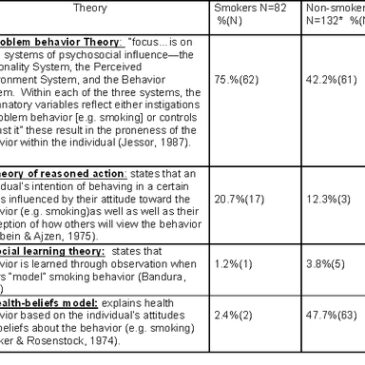During the past decade, the number of smokers in Mexico increased from 9 million to 13 million (Rasmussen-Cruz, Hidalgo-San Martín, Nuño-Gutiérrez, & Hidalgo-Rasmussen, 2006). The prevalence of Mexican smokers contrasts sharply with decreasing trends among other more wealthy western countries; in these settings, smoking has decreased 5-15% during recent years (Disease Control Priorities Project, 2006). The majority of smokers in Mexico are 18-29 years old. In addition, smoking in Mexico among people under the legal age of 18 has risen (Rasmussen-Cruz et al., 2006). Given increased awareness of the dangers associated with smoking, the observed increases among adolescent and young adult smokers are surprising. This week’s ASHES reviews a study that focused on motivation for tobacco use among Mexican college students. Understanding students’ motivation for smoking could help public health workers develop more effective prevention and intervention programs, with particular emphasis on programs that target young adults.
Rasmussen-Cruz, Hidalgo-San Martín, Nuño-Gutiérrez, and Hidalgo-Rasmussen (2006) surveyed Mexican university health sciences students (N=321) about their tobacco use and motives for tobacco use(1). Two hundred eighty two students aged 16-24 (M=20.3) completed an online questionnaire, which included questions about tobacco use, smoking-related motivations, knowledge about smoking-related diseases, risk behavior questions, sociodemographic characteristics such as socioeconomic status (SES), and age. Four theories guided the development of the motivation items; Figure provides a summary of these theories. The questionnaire also measured individuals’ overall functionality as defined by the five-parameters of growth, adaptation, decision-making ability, feelings of affection, and the quality of family life or friendship developed in the Apgar Family and Apgar Peer test (Smilkstein et al., 1982; as cited in (Rasmussen-Cruz, Hidalgo-San Martín, Nuño-Gutiérrez, & Hidalgo-Rasmussen, 2006).

Figure. Theories endorsed by smokers and non-smokers. Click image to enlarge.
The results of this survey indicated that 22.3% of students had smoked within the past month and 22% reported that they felt a deep need to smoke during the past year. In total, 23% of the sample admitted smoking (25.5% of males and 20.7% of females) during the past month. No significant statistical differences in tobacco consumption were observed for age, gender, SES, or functionality. The majority of smokers (65%) began between the ages of 15 and 19. Students endorsed many motivations for smoking: notably, 75.6% of smokers reported smoking to deal with problematic emotional behavior, and 20.7% reasoned that their smoking was logical because they had healthy friends who smoked. Male smokers were more likely to endorse the reasoned action theory (OR 3.35, CI 0.97—12.38, x2 4.47, p < .02) and female smokers were more likely to endorse the theory of problem behavior (OR 3.63, CI 1.61—8.20, X2 5.96, P < .01). Reported motivations for not smoking varied: 47.7% reported that they abstained because it is harmful, 46.2% saw it as a problematic form of behavior, and 29% of students said that one motive for abstinence was their lack of access to cigarettes. There were no differences in the motives given by females and males non-smokers.
There are several limitations to this study, including the sample population. These findings might not generalize because voluntary health science students might not accurately represent all smokers. In addition to the population specificity, the voluntary nature of the study might have biased the survey results. It is possible that there are differences between smokers and non-smokers that also might have influenced choosing to volunteer or not.
Within an institution of higher education, why are so many students lighting up? The authors suggest that motivation accounts, in part, for smoking behavior. Although it would seem logical that students who study health sciences (35% medicine, 15% dentistry, 11% nursing and 16% other disciplines such as psychology) would know better than to smoke. The evidence from this study suggests otherwise. Further, awareness of smoking risks might not be a sufficient deterrent to starting to smoke. Therefore intervention and prevention programs should address motivation as a core factor. Further, the motivations reported by non-smoking college students might also provide valuable information that can be used to strengthen prevention programs for college students that do smoke. Moving forward, researchers and public health works should develop different messages targeting separate population segments based on their differing motivations and smoking behaviors. A long-term smoker with entrenched tobacco dependence should not be targeted in the same way as a university student who recently began to smoke and is not yet dependent. Public health workers must address the unique demographic attributes of population segments to effectively prevent or treat smoking and its associated motivations. This study lends further support for the involvement of school counselors and other mental health professionals in designing prevention and treatment interventions due to the heavy influence emotional motivation has among smokers. More research on smoking motivation among different age groups and populations is needed to enhance prevention and intervention strategies.
–Erinn Walsh.
Notes
1. Among these students 28 were excluded because they did not fall between the required age range of 15-24 and 11 were not included because they did not complete the survey.
References
Bandura, A. (1977). Social learning theory. Englewood Cliffs, NJ: Prentice-Hall.
Becker, M., & Rosenstock, I. (1974). Health Behavior Theories. Retrieved December 7, 2006
Disease Control Priorities Project. (2006). Tobacco Addiction: Tobacco Controls Could Save 3 Million Lives a Year By 2030. Retrieved December 7, 2006, 2006
Fishbein, M., & Ajzen, I. (1975). Belief, Attitude, Intention, and Behavior: An Introduction to Theory and Research. Reading, MA: Addison-Wesley.
Jessor, R. (1987). Problem-behavior theory, psychosocial development, and adolescent problem drinking. British Journal of Addiction, 82(4), 331-342.
Rasmussen-Cruz, B., Hidalgo-San Martín, A., Nuño-Gutiérrez, B. L., & Hidalgo-Rasmussen, C. (2006). Tobacco Consumption and Motives for use in Mexican University Students. Adolescence, 41(162), 355-368.
What do you think? Please use the comment link below to provide feedback on this article.




